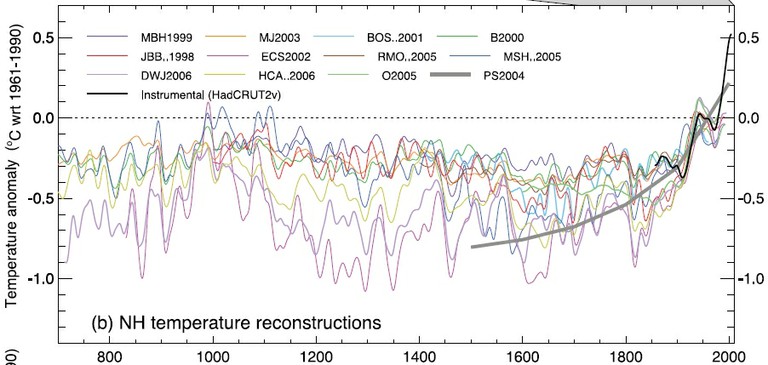Temperature (Global)
Global Temperature: NCAR/UCAR, NCDC, and NASA GISS Analysis: The current analysis uses surface air temperatures measurements from the following data sets: the unadjusted data of the Global Historical Climatology Network (Peterson and Vose, 1997 and 1998), United States Historical Climatology Network (USHCN) data, and SCAR (Scientific Committee on Antarctic Research) data from Antarctic stations. The basic analysis method is described by Hansen et al. (1999), with several modifications described by Hansen et al. (2001) also included. Modifications to the analysis since 2001 are described on the separate Updates to Analysis.
The National Academy of Sciences, National Research Council, Board on Atmospheric Science and Climate Present:
‘Climate Change: Lines of Evidence – Is Earth Warming?’
The National Academy of Sciences, National Research Council, Board on Atmospheric Science and Climate Present:
‘Climate Change: Lines of Evidence – How Much Warming?’
More Highs than Lows – A Growing Trend
Source: https://www.ucar.edu/news/releases/2009/maxmin.jsp
This graphic shows the ratio of record daily highs to record daily lows observed at about 1,800 weather stations in the 48 contiguous United States from January 1950 through September 2009. Each bar shows the proportion of record highs (red) to record lows (blue) for each decade. The 1960s and 1970s saw slightly more record daily lows than highs, but in the last 30 years record highs have increasingly predominated, with the ratio now about two-to-one for the 48 states as a whole.[ENLARGE] (©UCAR, graphic by Mike Shibao.)
Gerald Meehl – NCAR (National Center for Atmospheric Research)
Gerald “Jerry” Meehl is an NCAR senior scientist. His research includes connecting the solar cycle to subtle changes in weather and climate on Earth; examining the consequences of global warming, including heat waves, droughts, storms, and other weather extremes; regional climate change; and El Niño and other influences of the tropics on global climate.
Twice as many record-breaking high temperatures have been set compared to record lows across the U.S. in recent decades (see https://www.ucar.edu/news/releases/200…). For future climate, computer models show the ratio climbing to 20:1 by 2050 and 50:1 by 2100.
Day-to-day variability means we still get record cold days, but the record highs are far exceeding the lows.
NCDC (National Climate Data Center) Analysis
- Background – FAQ
- Global Mean Temperature Estimates
- Gridded Dataset
- The Global Anomalies and Index Data
- Additional Websites
- References
Hadley Met Center
Global Temperature Record

(this graph of HadCRUT3 is also available as Encapsulated PostScript and PDF
suitable for publication and the data are available as Comma-Separated Values)
GISS Surface Temperature Analysis
NASA/GISS Analysis
Analysis Graphs and Plots
GISS Surface Temperature Analysis
Analysis Graphs and Plots
This page is updated each month by an automatic procedure. Additional figures based on the GISTEMP analysis which require manual effort to create are available from Columbia University webpages maintained by Dr. Makiko Sato; see page 1 and page 2.
Click on any graph to view an enlargement of the image. PDF documents require a special viewer such as the free Adobe Reader.
Global Annual Mean Surface Air Temperature Change


Line plot of global mean land-ocean temperature index, 1880 to present, with the base period 1951-1980. The dotted black line is the annual mean and the solid red line is the five-year mean. The green bars show uncertainty estimates. [This is an update of Fig. 1A in Hansen et al. (2006).]
Figure also available as PDF, or Postscript. Also available are tabular data.
Our traditional analysis using only meteorological station data is a line plot of global annual-mean surface air temperature change, with the base period 1951-1980, derived from the meteorological station network [This is an update of Figure 6(b) in Hansen et al. (2001).] Uncertainty bars (95% confidence limits) are shown for both the annual and five-year means, account only for incomplete spatial sampling of data.
Figure also available as PDF, or Postscript. Also available are tabular data.
Annual Land and Ocean Mean Temperature Change
See page 2.
Annual Mean Temperature Change for Three Latitude Bands

Source: https://data.giss.nasa.gov/gistemp/graphs_v3/Fig.B.gif
Annual and five-year running mean temperature changes, with the base period 1951-1980, for three latitude bands that cover 30%, 40% and 30% of the global area. Uncertainty bars (95% confidence limits) are based on spatial sampling analysis. [This is an update of Figure 5 in Hansen et al. (1999).]
Figure also available as PDF, or Postscript, Also available is a table.
Annual Mean Temperature Change for Hemispheres

Annual and five-year running mean temperature changes with the base period 1951-1980 for the northern (red) and southern (blue) hemispheres.
Figure also available as PDF, or Postscript, Also available is a table.
Global Monthly Mean Surface Temperature Change

Source: https://data.giss.nasa.gov/gistemp/graphs_v3/Fig.C.gif
Line plot of monthly mean global surface temperature anomaly, with the base period 1951-1980. The black line shows meterological stations only; red circles are the land-ocean temperature index, as described in Hansen et al. (1999). The land-ocean temperature index uses sea surface temperatures obtained from satellite measurements of Reynolds and Smith (1994). [This is an update of Figure 8 in Hansen et al. (1999).]
Figure also available as PDF, or Postscript. Also available are tabular data.
Annual Mean Temperature Change in the United States

Source: https://data.giss.nasa.gov/gistemp/graphs_v3/Fig.D.gif
Annual and five-year running mean surface air temperature in the contiguous 48 United States (1.6% of the Earth’s surface) relative to the 1951-1980 mean. [This is an update of Figure 6 in Hansen et al. (1999).]
Also available as PDF, or Postscript. Also available are tabular data.
Seasonal Mean Temperature Change

Source: https://data.giss.nasa.gov/gistemp/graphs_v3/Fig.E.gif
Temperature index change (with the base period 1951-1980) since 1950 at seasonal resolution, for the globe (upper line) and for low latitudes (lower line). [This is an update of Figure 7 in Hansen et al. (1999).] Green triangles mark large volcanic eruptions. SST at Nino 3.4 is the 12-month running mean.
Also available as PDF, or Postscript. Also available are tabular data.
(Last modified: Sat Feb 23 13:28:26 EST 2013)




